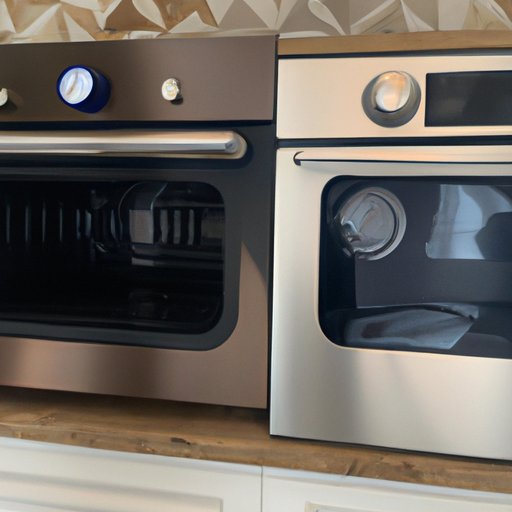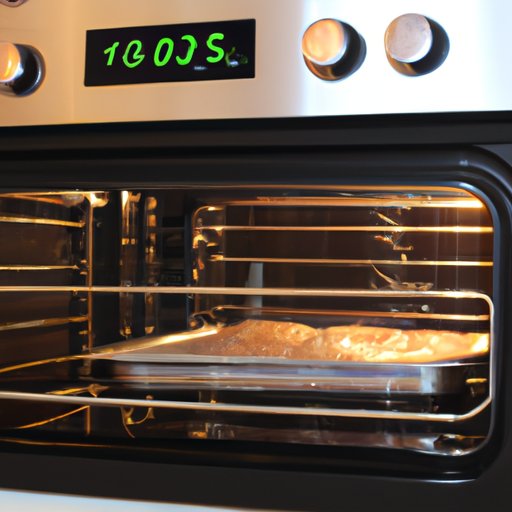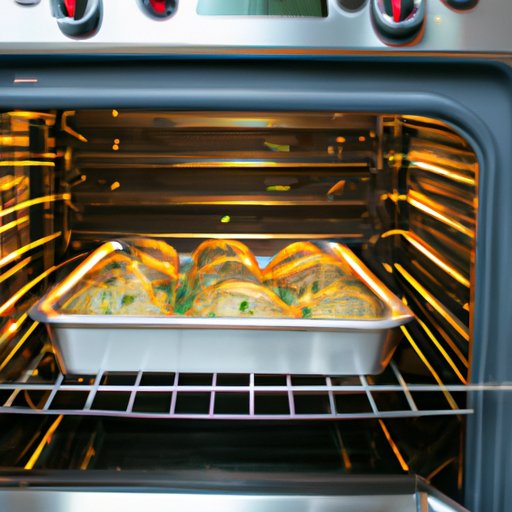Introduction
Convection ovens are becoming increasingly popular in home kitchens due to their ability to cook food more quickly and evenly than traditional ovens. But what exactly is a convection oven, and how does it work? In this article, we will explore the science behind how a convection oven works, as well as its benefits and tips for getting the best results.
Exploring the Science Behind How a Convection Oven Works
A convection oven uses fans to circulate hot air around the food, which helps to cook the food more quickly and evenly than a traditional oven. To understand how this works, it’s helpful to look at the science behind heat transfer.
Heat Transfer
Heat transfer is the process by which heat energy is transferred from one object or area to another. Heat can be transferred in three different ways: conduction, convection, and radiation. Conduction occurs when two objects come into contact with each other and heat is transferred from the hotter object to the cooler one. Convection occurs when a fluid (such as air or water) carries heat energy from one place to another. Radiation occurs when heat energy is transferred through electromagnetic waves.
The Fan and Heating Element
In a convection oven, there is a fan and heating element that help to circulate the hot air around the food. The fan pulls in cool air from outside the oven and passes it over the heating element, which warms the air. The warm air is then pushed back into the oven, where it circulates around the food. This helps to cook the food more quickly and evenly than a traditional oven.
Controlling the Temperature
In order to ensure that the food cooks properly, it is important to control the temperature of the oven. This is done by adjusting the settings on the oven’s thermostat. The thermostat allows you to set the desired temperature and the oven will maintain that temperature until it is changed again.
A Step-by-Step Guide to Using a Convection Oven
Now that we have explored the science behind how a convection oven works, let’s take a look at how to use one. Here is a step-by-step guide to using a convection oven:
Preparing the Oven
Before you begin cooking, it is important to make sure that the oven is clean and free of debris. It is also a good idea to check the racks and adjust them as needed.
Preheating the Oven
Once the oven is prepared, you can preheat it to the desired temperature. This will help to ensure that your food cooks evenly.
Setting the Temperature
Once the oven has reached the desired temperature, you can set the temperature on the oven’s thermostat. You may need to adjust this setting depending on the type of food you are cooking.
Placing Food in the Oven
Once the oven is preheated and the temperature is set, you can place the food in the oven. Be sure to place the food on a baking sheet or in a roasting pan to allow the hot air to circulate around it.
Adjusting Cooking Time
It is important to adjust the cooking time according to the type of food you are preparing. Since a convection oven cooks food more quickly than a traditional oven, you may need to reduce the cooking time slightly.
Checking Doneness
Once the food has been in the oven for the desired amount of time, it is important to check the doneness. This can be done by using a thermometer or by cutting into the food to check for doneness.

Comparing Traditional and Convection Ovens
Now that we have explored how a convection oven works, let’s take a look at how it compares to a traditional oven. There are three main differences: cook time, heat distribution, and moisture.
Cook Time
One of the biggest advantages of a convection oven is that it cooks food more quickly than a traditional oven. This is because the fan helps to circulate the hot air around the food, which helps to cook it more quickly and evenly.
Heat Distribution
Another advantage of a convection oven is that it distributes heat more evenly than a traditional oven. This helps to ensure that the food cooks evenly and prevents burning or undercooking.
Moisture
Finally, a convection oven helps to retain moisture better than a traditional oven. This is because the fan helps to circulate the air around the food, preventing it from drying out.

The Benefits of Cooking with a Convection Oven
There are several benefits to cooking with a convection oven. These include faster cooking times, more even cooking, and improved texture.
Faster Cooking Times
As mentioned above, one of the biggest benefits of a convection oven is that it cooks food more quickly than a traditional oven. This means that you can get dinner on the table faster.
More Even Cooking
A convection oven also helps to cook food more evenly than a traditional oven. This helps to prevent burning or undercooking, and ensures that all parts of the food are cooked properly.
Improved Texture
Finally, a convection oven helps to improve the texture of the food. The fan helps to circulate the hot air around the food, which helps to keep it moist and prevents it from drying out.
Tips for Getting the Best Results from a Convection Oven
Now that we have explored the benefits of cooking with a convection oven, let’s take a look at some tips for getting the best results. These include using the right type of pans, adjusting your recipes, and checking on food regularly.
Use the Right Type of Pans
It is important to use the right type of pans when cooking in a convection oven. Darker pans absorb more heat, so it is best to use light-colored pans to prevent burning. It is also important to use pans with low sides to allow the hot air to circulate around the food.
Adjust Your Recipes
Since a convection oven cooks food more quickly than a traditional oven, it is important to adjust your recipes accordingly. This means reducing the cooking time slightly to prevent burning or undercooking.
Check on Food Regularly
Finally, it is important to check on food regularly while it is cooking. This will help to ensure that it is cooked properly and prevent burning or undercooking.
What to Know Before Buying a Convection Oven
If you are considering buying a convection oven, there are a few things to keep in mind. These include size, features, and cost.
Size
It is important to consider the size of the oven when making your purchase. Make sure that it is large enough to accommodate your needs, but not so large that it takes up too much space in your kitchen.
Features
It is also important to consider the features of the oven. Look for features such as adjustable temperature settings, timers, and preprogrammed settings.
Cost
Finally, it is important to consider the cost of the oven. Convection ovens can range in price from relatively inexpensive models to more expensive ones with more features.

Recipes and Techniques for Making the Most of Your Convection Oven
Now that you know what to consider when buying a convection oven, let’s take a look at some recipes and techniques for making the most of it. These include roasting, baking, broiling, and reheating.
Roasting
Roasting is a great way to make the most of your convection oven. It is a fast and easy way to cook vegetables, meats, and other foods. For best results, use a shallow roasting pan and adjust the cooking time accordingly.
Baking
Baking is another great way to make use of your convection oven. Use dark baking pans to absorb more heat and adjust the cooking time accordingly. Also, avoid opening the oven door too often, as this will cause the temperature to drop.
Broiling
Broiling is a great way to add a crispy crust to meats and other foods. Be sure to preheat the oven before broiling and adjust the cooking time accordingly.
Reheating
Finally, a convection oven can be used to reheat leftovers. It is important to adjust the cooking time accordingly to prevent burning or undercooking.
Conclusion
Convection ovens are becoming increasingly popular in home kitchens due to their ability to cook food more quickly and evenly than traditional ovens. By understanding the science behind how a convection oven works and following some simple tips, you can get the best results from your oven. Whether you are roasting, baking, broiling, or reheating, a convection oven can help you get dinner on the table faster and more evenly.
(Note: Is this article not meeting your expectations? Do you have knowledge or insights to share? Unlock new opportunities and expand your reach by joining our authors team. Click Registration to join us and share your expertise with our readers.)
